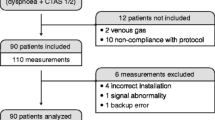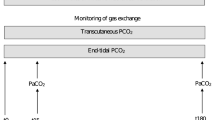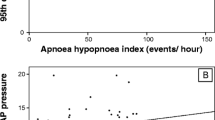Abstract
Objective
To determine the reliability of estimating arterial CO2 pressure (PaCO2) using a recently introduced transcutaneous CO2 pressure (PtcCO2) monitor in severe obese patients.
Design
Observational and interventional study.
Setting
District hospital with respiratory ward and bariatric surgery unit.
Patients and methods
PtcCO2 was measured in 35 obese patients with varied pathology, including chronic obstructive pulmonary disease, obstructive sleep apnea syndrome and hypoventilation syndrome. Ten minutes after the probe had been attached to an earlobe, PtcCO2 was recorded immediately before arterial blood sampling. The PtcCO2 and PaCO2 values obtained with two methods were compared by Bland–Altman analysis. In a subgroup of 18 obese patients with chronic obstructive pulmonary disease and/or obstructive sleep apnea syndrome with moderate to severe hypercapnia both PtcCO2 and PaCO2 were re-evaluated during continuous positive airways pressure (CPAP) or bi-level positive airway pressure (Bi-PAP) treatment.
Results
The mean difference between PaCO2 and PtcCO2 was −1.4 mmHg, and the standard deviation of the difference was 1.3 mmHg. Bland–Altman analysis showed generally good agreement between the two methods with a 95% limit of agreement of −4 to 1.1. The agreement between methods did not significantly change before and during cPAP or Bi-PAP treatment in hypercapnic patients.
Conclusions
The accuracy of estimation of PaCO2 by transcutaneous monitoring was generally good in comparison with standard arterial blood gases examination. The device appears to be promising for use in obese patients to evaluate abnormalities in their alveolar ventilation.



Similar content being viewed by others
References
Franklin ML (1995) Transcutaneous measurement of partial pressure of oxygen and carbon dioxide. Respir Care Clin N Am 1:119–131
Parker SM, Gibson GJ (2007) Evaluation of a transcutaneous carbon dioxide monitor (“TOSCA”) in adult patients in routine respiratory practice. Respir Med 101(2):261–264
Bendjelid K, Schutz N, Stotz M, Gerard I, Suter PM, Romand JA (2005) Transcutaneous PCO2 monitoring in critically ill adults: clinical evaluation of a new sensor. Crit Care Med 33:2203–2206
Bernet-Buettiker V, Ugarte MJ, Frey B, Hug MI, Baenziger O, Weiss M (2005) Evaluation of a new combined transcutaneous measurement of PCO2/pulse oximetry oxygen saturation ear sensor in newborn patients. Pediatrics 115:e64–e68
Griffin J, Terry BE, Burton RK, Ray TL, Keller BP, Landrum AL, Johnson JO, Tobias JD (2003) Comparison of end-tidal and transcutaneous measures of carbon dioxide during general anaesthesia in severely obese adults. Br J Anaesth 91:498–501
Dullenkopf A, Bernardo SD, Berger F, Fasnacht M, Gerber AC, Weiss M (2003) Evaluation of a new combined SpO2/PtcCO2 sensor in anaesthetized paediatric patients. Paediatr Anaesth 13:777–784
Williams AJ (1998) ABC of oxygen: assessing and interpreting arterial blood gases and acid-base balance. Br Med J 317:1213–1216
Bland JM, Altman DG (1986) Statistical methods for assessing agreement between two methods of clinical measurement. Lancet 1:307–310
Eberhard P, Gisiger PA, Gardaz JP, Spahn DR (2002) Combining transcutaneous blood gas measurement and pulse oximetry. Anesth Analg 94:S76–S80
Severinghaus JW, Peabody JL, Thunstrom AM, Stafford M (1978) Transcutaneous oxygen measurements: calibration analysis and electrode stabilization methods. Acta Anaesthesiol Scand Suppl 70:180–182
Bolliger D, Steiner LA, Kasper J, Aziz OA, Filipovic M, Seeberger MD (2007) The accuracy of non-invasive carbon dioxide monitoring: a clinical evaluation of two transcutaneous systems. Anaesthesia 62:394–399
Rodriguez P, Lellouche F, Aboab J, Buisson BC, Brochard L (2006) Transcutaneous arterial carbon dioxide pressure monitoring in critically ill adult patients. Intensive Care Med 32:309–312
Giner J, Casan P, Belda J, Gonzalez M, Miralda RM, Sanchis J (1996) Pain during arterial puncture. Chest 110:1443–1445
Hudson TL, Dukes SF, Reilly K (2006) Use of local anesthesia for arterial punctures. Am J Crit Care 15:595–599
Eberhard P (2004) Comparison of transcutaneous and end-tidal CO2-monitoring for rigid bronchoscopy during high-frequency jet ventilation. Acta Anaesthesiol Scand 48:260
Janssens JP, Howarth-Frey C, Chevrolet JC, Abajo B, Rochat T (1998) Transcutaneous PCO2 to monitor noninvasive mechanical ventilation in adults: assessment of a new transcutaneous PCO2 device. Chest 113:768–773
Author information
Authors and Affiliations
Corresponding author
Additional information
Present address: M. Maniscalco, Largo delle Mimose 1, 80131 Napoli, Italy
Rights and permissions
About this article
Cite this article
Maniscalco, M., Zedda, A., Faraone, S. et al. Evaluation of a transcutaneous carbon dioxide monitor in severe obesity. Intensive Care Med 34, 1340–1344 (2008). https://doi.org/10.1007/s00134-008-1078-8
Received:
Accepted:
Published:
Issue Date:
DOI: https://doi.org/10.1007/s00134-008-1078-8




